Jana al-Issa | Hassan Ibrahim | Hussam al-Mahmoud
In addition to the ruins of homes whose residents were left homeless, the devastating earthquake accumulated humanitarian needs in areas of northwestern Syria that were not at their best pre-disaster due to the decline in international support and funding for humanitarian and medical organizations operating on the ground under various pretexts.
The emergency situation necessitated a quick response, with additional medical and relief needs that were not easy to deal with, despite launching civil donation campaigns, to which the Syrians responded amid UN procrastination in terms of providing the required aid to save the situation in the affected area, specifically equipment, and machinery to lift debris and rescue those stuck under the rubble.
Rescue, shelter, food, and medical needs met in a short time of great distress, requiring an exceptional humanitarian response, different from that provided by organizations in normal situations by launching voluntary donation campaigns that managed the response within limits.
After the level of the disaster gradually increased and there was a transition from an ongoing and painstaking search to rescue those stuck under the rubble to the search and recovery of bodies by the Syria Civil Defense (SCD), also known as the “White Helmets,” and civilians, without adequate equipment and machinery, the humanitarian crisis was clearly revealed in the face of families losing their homes with all their contents, along with the medical sector’s transition from first aid to surgical handling of the cases created by the earthquake.
In the face of all these challenges and the absence of governmental effectiveness, the organizations took over the management of the transitional emergency phase between the earthquake disaster and its absorption, depending on what it collected or what it will collect later in terms of donations with the aim of rebuilding what was destroyed by the earthquake.
In this file, Enab Baladi highlights the nature of the initial response to the devastating earthquake disaster in the regions of northwestern Syria, where relief and humanitarian authorities and organizations are numerous. It also illustrates the magnitude of needs over the next few periods, the nature of the “post-acute” phase needs, and ways to secure them, with a view to compensating those affected by the earthquake for part of their loss.
Saving lives…
Limited capacities to face the “disaster of the century”
Hours after the 7.7-magnitude earthquake, the epicenter of which was in the Turkish province of Kahramanmaraş on the 6th of February, affecting four Syrian governorates as well, followed by another 7.6-magnitude earthquake in the same province at noon of the same day, the Syrian Civil Defense (SCD), the Syrian Interim Government (SIG), and the Syrian Salvation Government (SSG) declared the north of Syria a “disaster-stricken area.”
Volunteer teams, people, and local authorities in northwestern Syria were racing the clock to save those stuck under the rubble following the earthquake, which resulted in 2274 deaths and left 12,400 injured in the area in a non-final toll.
The Civil Defense teams, local organizations and councils, military factions, and two governments in northwestern Syria responded with their volunteers, elements, and machinery to more than 550 completely destroyed buildings and more than 1570 partially destroyed buildings, in over 60 cities, towns, and villages, amid poor capacities and delayed access to much-needed aid consisting of equipment and machinery under the pretext of logistical impediments.
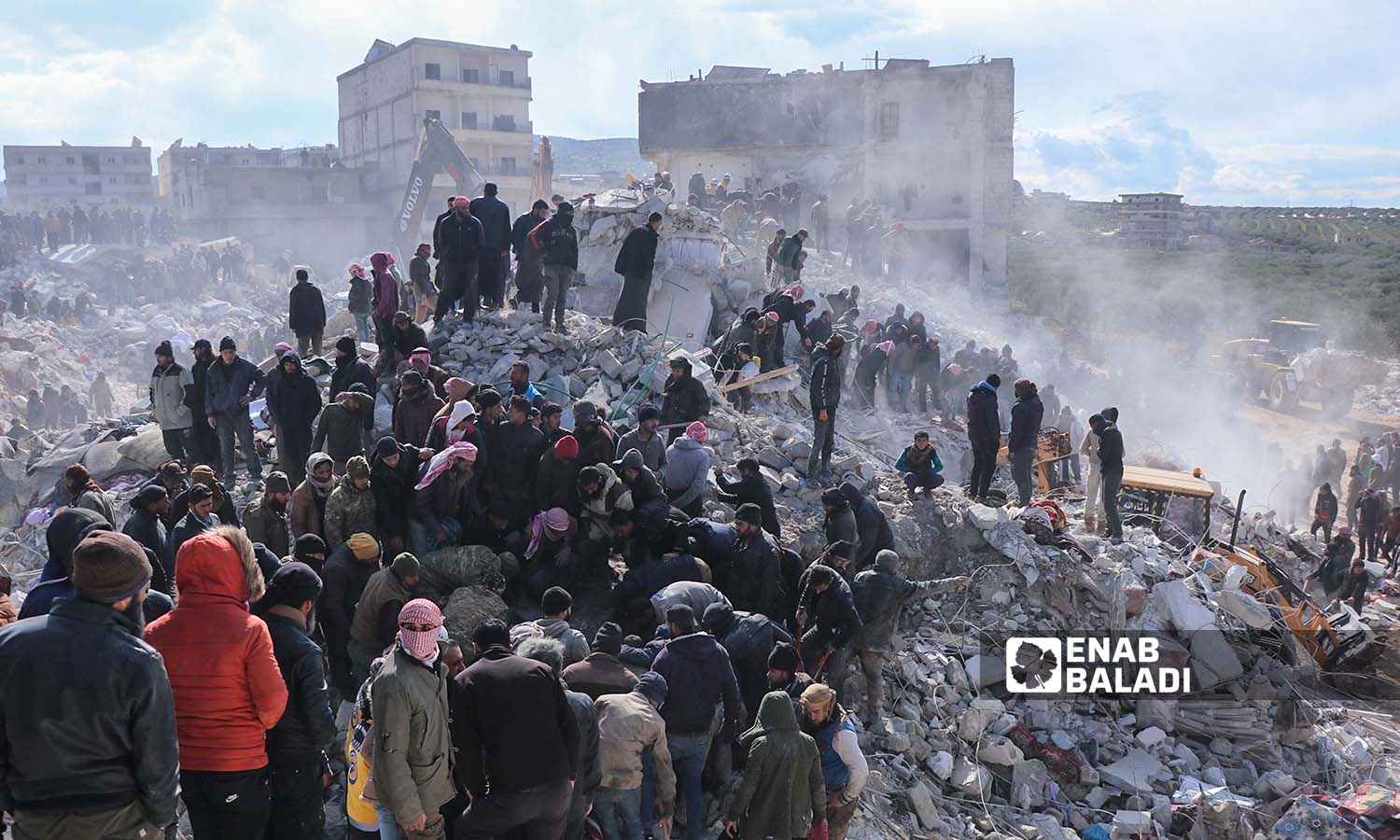
Rescue teams and volunteer residents search for survivors among the rubble of collapsed buildings in the village of Basnia, near Harem town on the Syrian-Turkish border, following the massive earthquake that struck Turkey and northwestern Syria – February 7, 2023 (Enab Baladi/Mohammad Nasan Dabel)
White Helmets facing the disaster
The first hours of the earthquake passed quickly for the volunteers of the Syrian Civil Defense (SCD), the White Helmets, who tirelessly worked day and night to rescue the victims, while the hours passed very slowly for the lives under the rubble that were searching for life above them.
The deputy director of the Syria Civil Defence (SCD), Mounir Mustafa, explained to Enab Baladi that the response began with the earliest moments of the earthquake, with an immediate declaration of a state of emergency and acting in maximum capacity. The number of volunteers who have started working directly in search and rescue operations has reached 2900 female and male volunteers from all disciplines, water rescue, firefighting, emergency, etc., with all available heavy machinery and equipment.
The SCD has 3300 volunteers, of whom 2900 have been assigned by the SCD’s administration to immediate response in search and rescue operations, while the rest of the volunteers were involved in media, administrative, and logistical work, and securing supplies for the operating teams, according to Mustafa. The teams did not work in shifts, as a large number of them refused to leave their stations during the first 48 hours, he added.
Mustafa said that the teams were distributed according to priorities and the type of management. The team leader is the one who determines the priority of work and distributes the teams to the area that suffers from a shortage and where there is great destruction and directs the cadres to support the most affected areas. There was also direct oversight of the teams’ deployment.
Mustafa identified two types of obstacles faced by SCD volunteers, both natural and technical; natural obstacles relate to the large area devastated by the earthquake, with damaged points extending from Jarablus, in the northeastern countryside of Aleppo, to the western and southern countryside of Idlib, with a strip about 200 kilometers long, comprising more than 60 ravaged villages, towns, and cities.
Natural obstacles included aftershocks that posed a risk to volunteers’ lives in the form of injuries even though they were trained, as well as weather factors such as rain and hail, which had a negative impact and increased the likelihood of buildings collapsing.
Technical obstacles have been the lack of equipment and machinery that are insufficient to respond to this enormous amount of destruction, as well as the equipment’s inability to cope with the disaster. The absence of sensors and thermal cameras has been a major impediment to expediting rescue operations.
108 hours after the earthquake, the SCD announced that its operations in Syria had begun to take the path of search and recovery after chances of survival for those stuck under the rubble became very rare without any assistance, equipment, and machinery to save those who are trapped under the rubble.
During a press conference on February 10, the Director of the Syria Civil Defense (SCD), Raed al-Saleh, held the United Nations responsible for the delay in the arrival of aid, stressing that the lack of effective equipment was a major reason for the inability to save many, after numerous appeals to secure the heavy machinery and fuel needed to operate it.
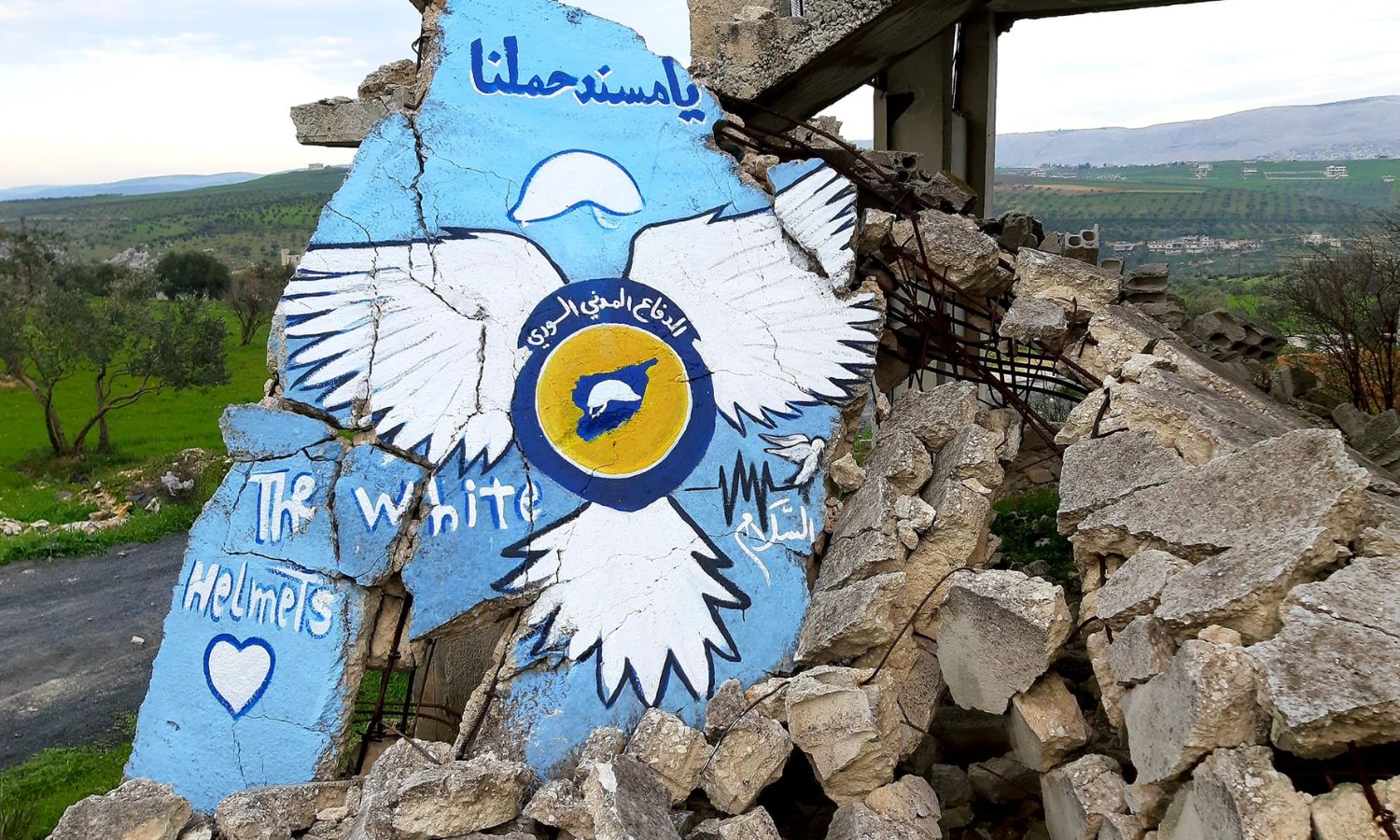
A mural on the ruins of a destroyed house in northwestern Syria, by the artist Salam Hamodh – February 15, 2023 (Facebook/Salam Hamodh)
Volunteer teams, A “temporary” solution
Since the first day of the earthquake, tens of thousands of people staying in the open has created the need for rapid action to secure temporary shelters to protect them from low temperatures and possible cracks in homes that may fall as a result of more than 4000 aftershocks since February 6.
In an area not previously accustomed to natural disasters of this magnitude, the de facto authorities or relevant organizations operating in the region did not possess sufficient material and logistical expertise or capacities to deal quickly with the aftermath of the earthquake, which accelerated significantly beyond capacity during the early hours.
Dozens of volunteer teams, organizations, and associations responded to the earthquake disaster and helped according to their relief, medical, humanitarian, and other functions, although their cadres, whether in Turkey or Syria, were also affected by the disaster.
During the early hours, many organizations worked to secure shelter for those affected by relocating them to either previously established housing villages or temporary camps.
Suhaib Tulaimat, the program director of the Ataa Humanitarian Relief Association operating in Turkey and northern Syria, told Enab Baladi that the association’s efforts focused on several departments, like most relief organizations, during the first week of the earthquake disaster. The first response was to support the Syria Civil Defense (SCD) by rescuing the stranded victims, while the response after that was multi-sectoral by securing shelters and providing those affected with non-food items related to shelter and heating, such as heaters, clothes, coal, and blankets, distributing ready-made meals, and later distributing food baskets.
Tulaimat pointed out that the implementation of existing programs and projects that depend on distribution focused their efforts on those affected by the earthquake as places and materials, while programs and projects related to the development rather than relief or response aspects were temporarily halted in order to establish and equip reception centers for the affected people. Following the establishment of the said centers, the programs were resumed according to plan.
The coordination between the organizations operating during the first response hours was not entirely absent but was confined to the field level only through field projects and field office managers, with a view to coordinating efforts to avoid denial of services to certain areas at the expense of replicating the same services in others, Tulaimat explicated.
The director of the Response Campaigns Department of the Molham Volunteering Team operating in northern Syria and Turkey, Faisal al-Aswad, told Enab Baladi that the team’s response covered all sectors in which it operates, such as medical, relief, transport, and evacuation sectors, as it declared a state of emergency in all areas of its deployment in Syria and Turkey.
The Molham Volunteering Team has suspended all departments and all projects to respond fully to the disaster in Syria and Turkey, al-Aswad said.
The media spokesperson for the Insan Charity for Relief and Development organization operating in the Aleppo countryside, Abdul Hamid al-Abdullah, told Enab Baladi that the organization worked to equip temporary shelters for those affected by the earthquake in the town of Jindires, which was the worst affected area in the north.
Al-Abdullah explained that the organization’s response was now temporary. As long as there are needs, their teams will remain as responsive as possible, providing first aid to the wounded and receiving patients in mobile clinics. It also distributes some food baskets and daily meals.
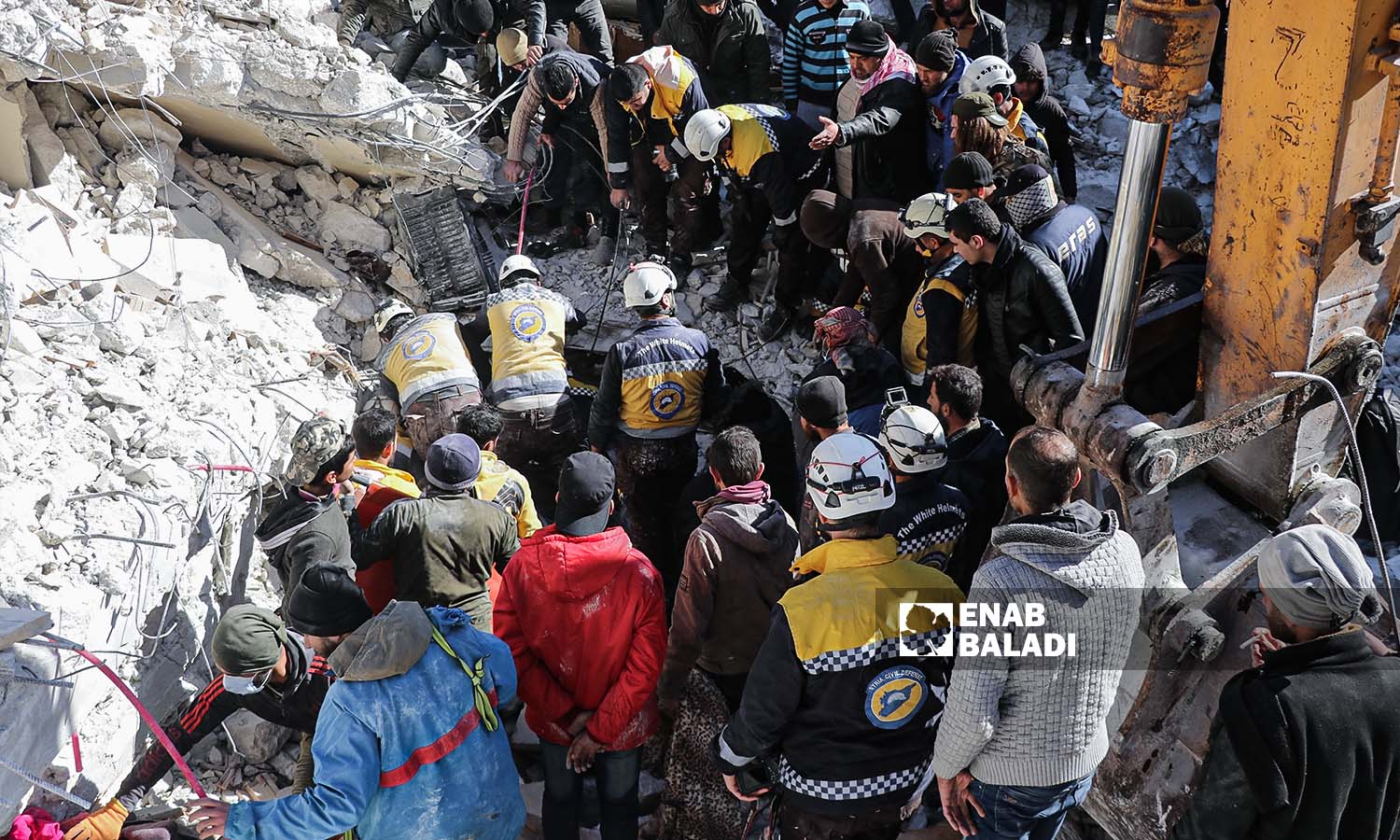
Volunteers and civilians in northwestern Syria, trying to rescue the injured and recover the victims from under the rubble in Salqin following the massive Feb-6th earthquake – February 7, 2023 (Enab Baladi/Mohammad Nasan Dabel)
Local authorities are present
Since the first hours of the earthquake, the local authorities in northwestern Syria also moved within the available capabilities and provided, as a first stage, assistance in supporting the Syria Civil Defense (SCD) with fuel and vehicles on the one hand and secured the arrival of the injured to hospitals as soon as possible after they were pulled out from under the rubble and secured temporary shelters.
The Salvation Government, which controls Idlib governorate and parts of the countryside of Aleppo, responded during the first days of the disaster through 20,000 workers in its civil, security, and military institutions to provide assistance in rescuing the stranded and securing about 40 temporary shelters.
The Salvation Government’s work during the second phase focused on facilitating the support, entry, and protection of medical and relief teams from the Bab al-Hawa border crossing with Turkey, evacuating the cracked buildings, and removing the rubble.
It has also worked on assessing the damaged buildings, securing shelter, fighting monopoly, and disbursing cash and relief aid worth more than 20 million Turkish liras in principle to all affected families, according to what was announced by the commander of Hayat Tahrir al-Sham (HTS) which has military influence in the region, “Abu Mohammad al-Jolani.”
The director of public relations in the Salvation Government, Jamal al-Shahoud, told Enab Baladi that the Ministry of Interior in the Salvation Government had mobilized more than 2,600 police units, special missions, and all the vehicles of the Ministry of Interior, including cranes, vehicles for transporting the wounded and the injured, and traffic police vehicles, since the first hours after the earthquake.
The “government” worked to secure protection, prevent thefts from occurring, and protect the property of those affected and received all the trusts that were taken out of the demolished buildings, documented and preserved, in order to hand them over to their owners and the families of the victims.
In the countryside of Aleppo, which the Syrian Interim Government (SIG) controls, the Ministry of Defense asked all military units and formations in the Syrian National Army (SNA) to provide assistance to the Syria Civil Defense members and the mechanisms required to rescue and aid the injured.
The checkpoints were also instructed to secure the rapid passage of ambulances, in addition to the local councils affiliated with the Interim Government providing shelters for the people.
The official spokesman for the SNA, the military wing of the Interim Government, Brig. Gen Ayman Sharara told Enab Baladi that the mechanisms and elements of the SNA are continuing their work alongside the people and organizations more than ten days after the earthquake.
A “crisis cell” was formed to protect the affected areas, to provide what is needed for the affected people, and to facilitate the work and protection of humanitarian organizations, adds Sharara.
The response to the earthquake disaster was not limited to local and military authorities and organizations, as the people responded to the disaster, each according to his ability, with donations, support, mechanisms, food, and physical effort. Trucks and cars loaded with aid arrived from families, activists, and Arab tribes in response to those affected.
No disaster agency to manage response campaigns
In any country, there is a body called the “Natural Disasters Authority,” which the region in northwestern Syria does not have, as references, expertise, tools, warehouses, equipment, and risk management are also absent for such a natural disaster, according to Dr. Bassem Hatahet, a specialist in the management of civil society organizations.
In the absence of all of this, and the sudden occurrence of the earthquake, the principle is that cooperation should be established with two main parties, the first of which is the Turkish authorities that are supervising the situation in northern Syria and the UN agencies working to provide aid, says Hatahet.
However, the absence of the “Natural Disasters Authority” prevents UN agencies and international bodies within the UN resolutions from providing assistance, including the delivery of heavy machinery, according to the expert.
This forced the rescue Civil Defense agency to rent mechanisms in addition to its own, which were not able to respond to a disaster of this kind since the earthquake was in a group of areas of more than 100 square kilometers, which means that if the mechanisms were found in advance, then their distribution over a stricken area will remain slow and incomplete.
In natural disasters, as in the case of earthquakes, five types of equipment must be available in the area in order to respond early and ensure that the number of victims is reduced, namely:
1- Heavy machinery.
2- Electronic and digital engineering mechanisms that determine the coordinates of the fall of buildings.
3- Mechanisms that are less heavy than digging machines, with the aim of removing and emptying large stones.
4- Thermal devices, which work through special sensors to sense the breathing or the body of the trapped persons, in addition to listening devices through which sounds can be heard and amplified at a depth of 30 meters.
5- Trained dogs, which are much faster than any electronic device.
In disaster management, work is divided into four parts, according to Dr. Bassem Hatahet. The first is research, and the second is shelter, which is to find alternative places for those affected by the disaster.
This is a situation that still does not exist in the north, despite the presence of dozens of organizations working in the shelter sectors, which are supposed to include a risk management department that guarantees the establishment of dozens of camps within hours.
While in the third section, within the methodology of work during disasters, field hospitals must be worked on to accommodate the large numbers of injuries.
Fourth, the existence of a center for statistics and documentation aimed at direct counting of victims and material damage, addressing immediate problems resulting from the disaster and limiting their exacerbation, and counting all kinds of needs (relief, experts, mechanisms) in a central manner to interact with UN and international organizations.
In a previous report, Hatahet told Enab Baladi that at a time of natural disasters falling within the framework of civil protection in international humanitarian law, there exists a special system different from natural situations, which is not present within local civil society organizations.
Hatahet divided civil protection in times of disasters into two parts, the first being the protection of victims who were “directly harmed.” The funds currently raised from voluntary donations do not contribute to the victims’ rescue but rather to the provision of food or medical assistance or tents as shelters for those affected by the earthquake.
The second part, which is “the repercussions of direct harm,” concerns the post-damage period, such as the fate of victims or demolished buildings. This part also does not exist within the system of work of local civil society organizations, according to Hatahet.
Medically, Work until the last breath
The situation was not in the best condition in the medical sector, and the sector has always suffered during the past years from a great shortage of its consumables and cadres due to many reasons, most notably the insufficient support provided to it and it has previously recorded, with the spread of diseases and epidemics in the region, a greater weakness in its capabilities.
The exposure of some medical personnel to direct effects as a result of the disaster, either by their death with their families or by remaining under the rubble of their homes, forced their colleagues to work continuous hours during the first days due to the multiplication of the number of injuries, which affected the capacity of medical centers and hospitals.
Most hospitals also lost their reserves of diesel and medical disposables, as they were all filled with patients during the first days of the disaster, and a number of them were placed in hospital corridors, which made some medical centers use resources that were listed for consumption within six months, in only one day.
The medical sector also faced several logistical obstacles, the first of which was the absence of electricity, which was naturally delivered to the region from Turkey, forcing hospitals and health centers to return to relying on diesel to run generators, for which no prior precautions were taken.
Unfortunate reality
Injuries as a result of the earthquake include cases that require surgical intervention after the medical centers have completed the first aid stage, but this step depends on unclear data, according to what the director of Idlib Central Hospital, Dr. Adel al-Dughaim said.
In an interview with Enab Baladi, al-Dughaim focused on the lack of a complete picture of the number of expected surgeries in the post-disaster period.
The doctor justified this by not being able to predict the development of the injuries resulting from the earthquake, such as multiple fractures and bruises.
In addition, the injured are still in the danger stage, and they may develop conditions that sometimes require amputation of limbs, especially for people who currently suffer from the “crush syndrome” or renal insufficiency and are subject to continuous dialysis.
“Crush injury” is a pathological condition caused by exposure to physical trauma due to prolonged pressure on any part of the body. It may occur due to the direct impact of trauma or pressure-related ischemia and can cause kidney failure.
Al-Dughaim also explained that solutions to the sector’s crises require restoring medical personnel and securing medical supplies and devices in the stricken area.
While the needs in the “post-acute” phase of the earthquake are represented in securing adequate medical supplies of all kinds, in addition to the raw materials required for dialysis operations, which requires support from international organizations and parties due to the difficulty of securing them locally on the one hand and the difficulty of bringing them into the region through Turkey on the other hand.
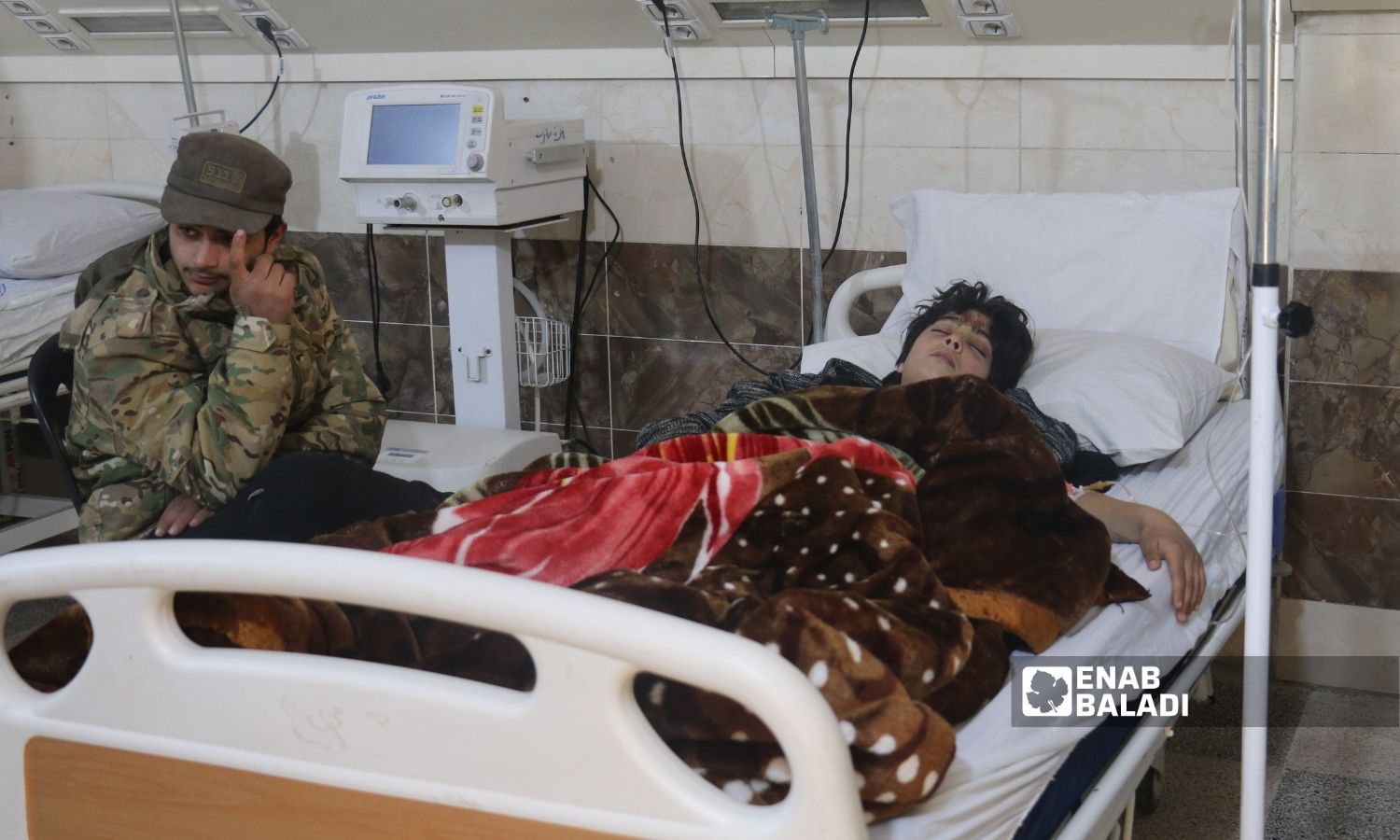
Injured people in al-Shifa Hospital in Afrin as a result of the massive earthquake – February 9, 2023 (Enab Baladi/Dayan Junpaz)
After shock, Need for management, coordination
The Syria Civil Defense moved to another level of response to deal with the effects of the earthquake after it completed the emergency response phase to the earthquake, which was manifested in the recovery of those trapped under the rubble in a continuous work around the clock to save the living, but it seems that the effects are long-term.
The Deputy Director of the Syria Civil Defense, Mounir Mustafa, explained that this phase of the response begins with opening roads and removing rubble from the main and secondary roads, which constitutes a major challenge due to the huge amount of destruction and rubble.
In addition, the team is moving, during the current period, to re-evaluate the buildings and determine what is habitable, in cooperation with engineers and specialists, and to define a mechanism for dealing with the buildings, through total demolition or removal of parts of them, according to Mustafa.
The efforts of relief organizations during the current and coming period focus on finding permanent places for those affected by the earthquake whose homes were destroyed or cracked and are no longer suitable for housing.
According to the statements of a number of officials of local relief organizations to Enab Baladi, the door for donations has been opened in this regard, and coordination has also begun with engineering specialists to start the planning phase for new residential villages and to design them internally according to needs.
Until the end of the second week after the earthquake occurred, the Molham Volunteering Team (which is one of the few Syrian teams that announces the amount of donations it receives) as part of the “Capable” campaign that it launched with the aim of rebuilding what was destroyed by the earthquake, collected more than $11 million, the amount which is approximately enough to build 2,247 homes out of 4000, given that the cost of insuring one home amounts to about $5,000.
Lack of coordination leads to unfairness
With many organizations announcing their intention to build permanent homes, and amid the absence of the role of local authorities in uniting their efforts to reach results that guarantee containing the effects of the disaster as soon as possible, these organizations have not yet reached joint coordination on programs and plans for building homes and identifying beneficiaries during the coming period.
Mustafa told Enab Baladi that the multiplicity of sub-local actors is one of the main obstacles to action during the coming period, which leads to the absence of a single governing body that plans and implements, and this requires dealing according to a tactical plan more than a strategic one.
Mustafa pointed out that there is an intention related to uniting efforts or reaching a joint operations room in order to distribute and follow up tasks and not to cause conflicts of work in one place.
Yahya al-Sayyed Omar, a researcher in political economy, said in an interview with Enab Baladi that coordination and cooperation between organizations would achieve high effectiveness in relief work and also ensure justice in aid distribution.
The expert points out that poor coordination between relief organizations working in the field of relief for the afflicted is not new in northern Syria. During the years of the war, relief and humanitarian work suffered a decline in the level of coordination, and this was reflected in the relief work after the earthquake.
Al-Sayyed Omar believes that the poor level of coordination between relief and humanitarian organizations operating in the affected areas is due to several reasons, including that these organizations obtain funding from different parties, as the organizations are forced to take into account the conditions of the donors, which may be different and disparate.
The lack of updated databases also leads to a decline in the level of coordination, in addition to the multiplicity of local political actors supervising relief work, and may lead to inequity in aid; for example, specific geographical areas may receive support from several organizations, while other areas are deprived.
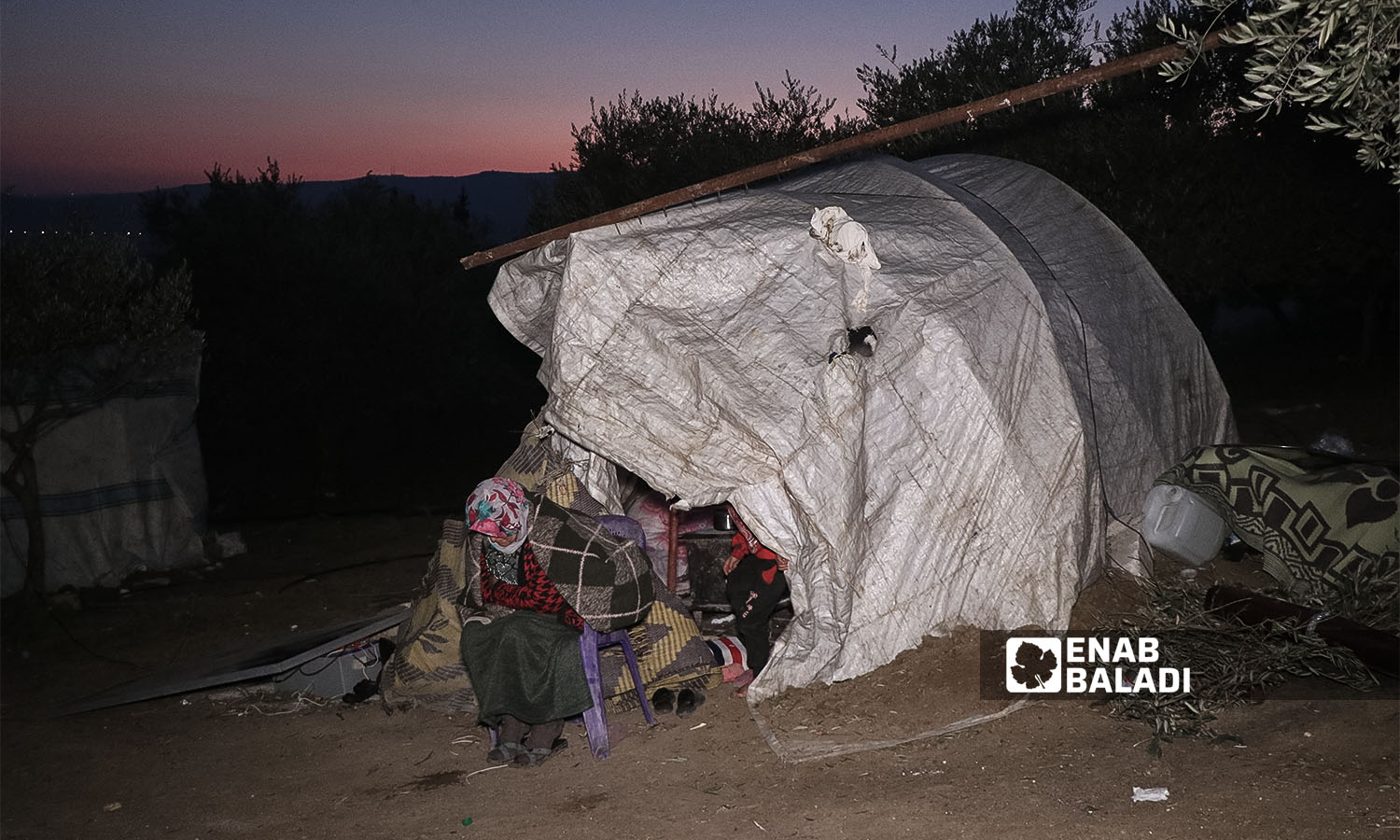
A woman displaced from her home due to the earthquake that hit northwestern Syria spreads out on agricultural land in the village of al-Hamziya in the countryside of Salqin, northern Syria – February 12, 2023 (Enab Baladi/Mohammad Nasan Dabel)
Demands for a higher relief body
With regard to the northern Syrian region, achieving the objectives of relief work requires high-level coordination between organizations. In order to achieve this, it is imperative that there be a high-level relief body in the region, under which the various relief organizations act, being the main directive for action.
This body is required to develop a demographic database of geographical scope so that the groups most in need are identified and the categories supported are registered. At the same time, it is imperative to ensure that local political authorities do not intervene in relief work since the limits of their intervention must not exceed the provision of logistical support to organizations, said al-Sayyed Omar.
In an interview with Enab Baladi, Bassem Hatahet, a specialist in the management of civil society organizations, criticized the lack of coordination between the organizations in light of the existence of such a disaster and the significant needs associated with it and the absence of a high relief body acting in this role alongside the Syria Civil Defense (SCD).
Coordination between organizations or the presence of a higher relief body results in the distribution of donations according to the most important needs, such as providing machinery and equipment to assist in the first phase of rescue, securing shelters for the earthquake-affected, and establishing committees to detect damage.
For instance, Hatahet pointed to the hazards resulting from the dams affected by the earthquake, whose collapse could cause other disasters.
Hatahet highlighted the importance of reaching an agreement with UN bodies to enter the north of Syria, stating that the mechanism for the entry of aid to the region is a periodic UN-accredited mechanism. Thus, if an agreement is reached with these bodies to allow the entry of civil society organizations, the latter can then receive necessary international support that is difficult for local organizations to collect.
if you think the article contain wrong information or you have additional details Send Correction
النسخة العربية من المقال
-
Follow us :
Most viewed
- Turkey moves to deploy air defense system in Syria
- Intentions for popular resistance amid Israeli escalation in southern Syria
- SDF to withdraw from Aleppo neighborhoods following agreement with Damascus
- Washington's conditions raise questions about its openness and goals in Syria
- Syrian returnees celebrate first Eid after liberation












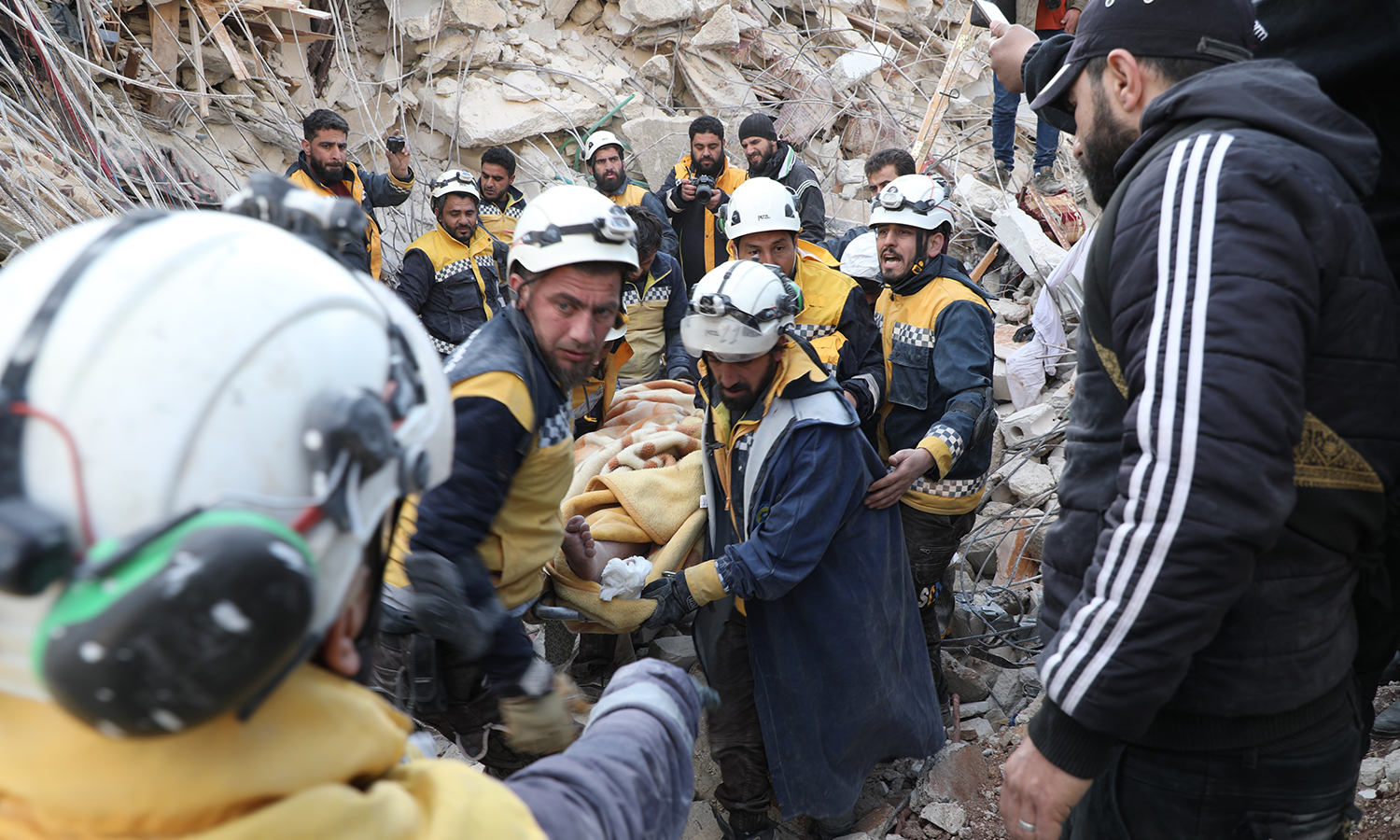
 The White Helmets volunteers pull a man out from under the rubble in Jindires town, following an earthquake that struck southern Turkey and northwestern Syria - February 11, 2023 (Civil Defense)
The White Helmets volunteers pull a man out from under the rubble in Jindires town, following an earthquake that struck southern Turkey and northwestern Syria - February 11, 2023 (Civil Defense)





 A
A
A
A
A
A
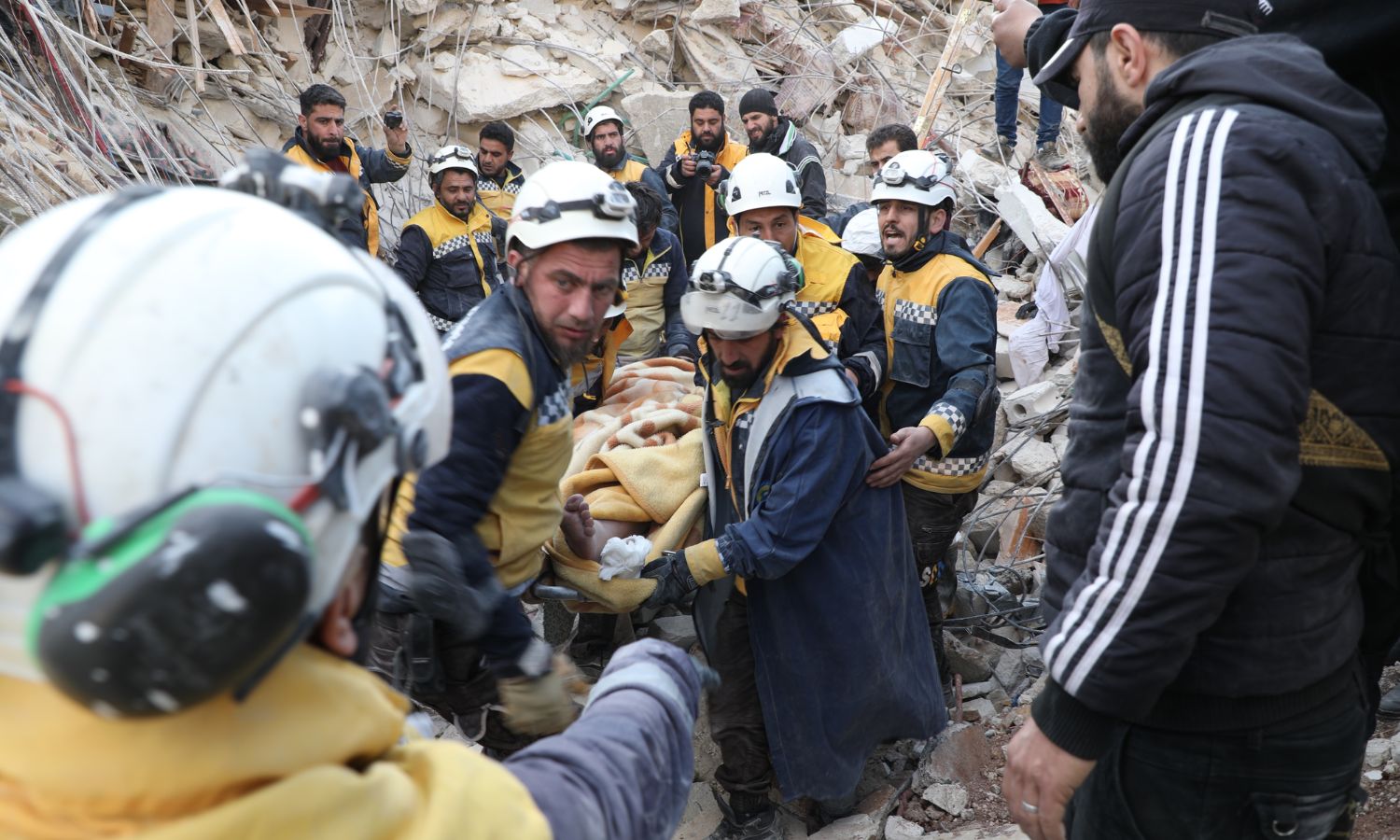
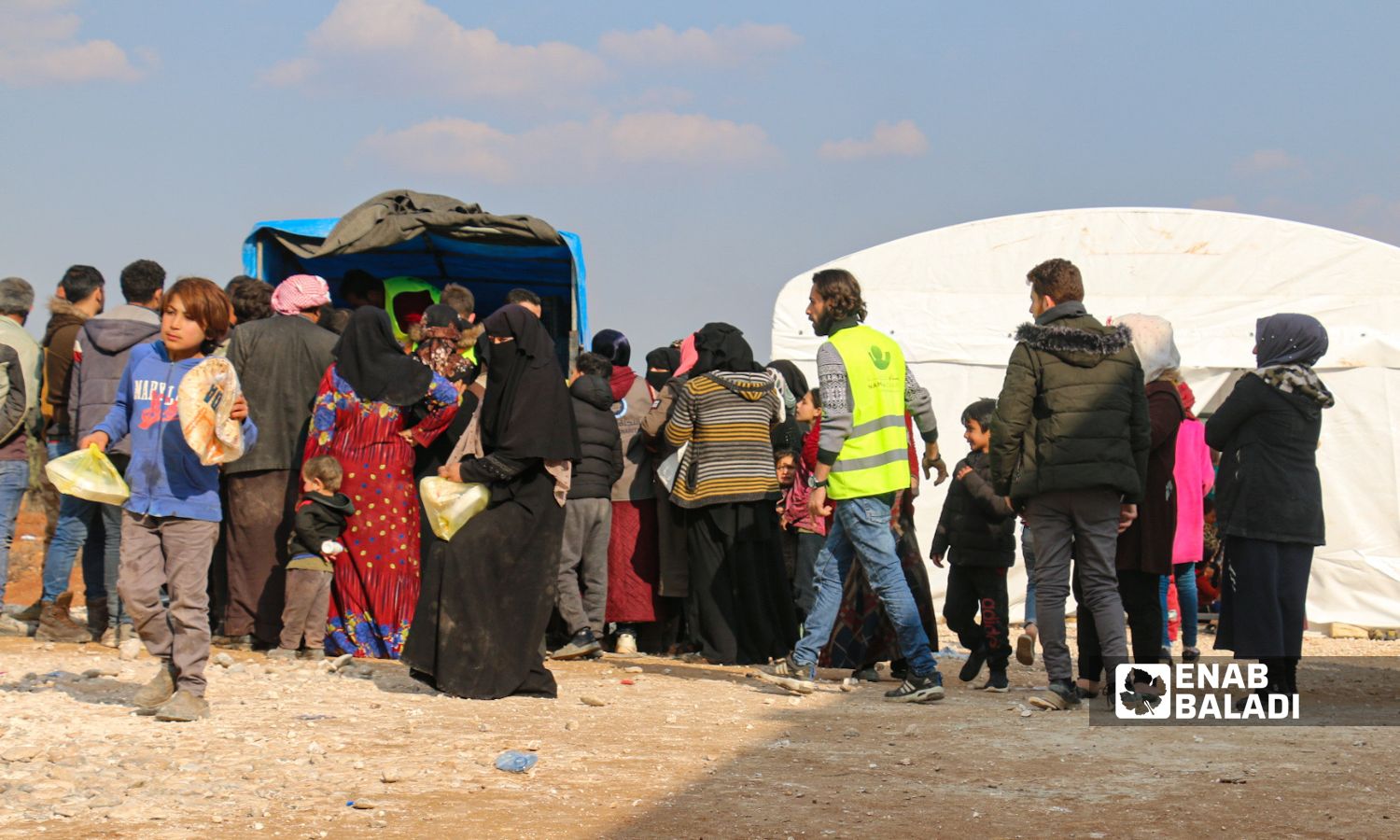





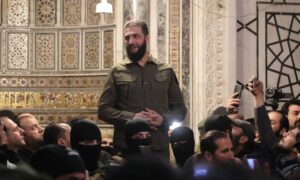
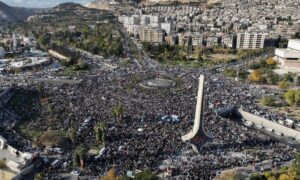
 More In-Depth
More In-Depth